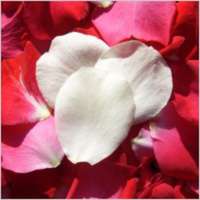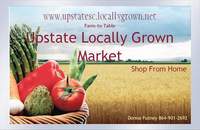The Weblog

This page contains news, event information, and other items added by the market managers. This is where you will find old newsletters, plus info not included in your weekly newsletter, plus the past year’s weekly newsletters. 10 pages at a time are visible. You may choose to go back further at the bottom of this page.
Thank you for your interest.
“Thanks to all who make this possible!!” ~
DM, Greenville SC
“I’m really happy with everything I received. How juicy and tasty
I’m so thankful for reliable growers and market.” ~ MC, Greenville SC
visit us on Facebook.
Upstate Locally Grown on Facebook
.
“Needing info on a plant? “Click here for Dave’s Garden Plant Search site”: PlantFiles search code:
Harvest News for 5/17/13 Edible Flower Know-How
This post expired on May 17, 2023.
-

Upstate Locally Grown Market CLEMSON
http://clemson.locallygrown.net/
To Contact Us
CLICK HERE TO UNSUBSCRIBE OR CHANGE YOUR ACCOUNT STATUS
TO CONTACT US
Market Administrator
Donna Putney
HARVEST NEWS EDITOR/ CLEMSON MARKET MANAGER
Heidi Williams
Recipes

Rose Petal Tea
Ingredients:2 cups fresh fragrant rose petals available “here”:
3 cups water
Honey or granulated sugar to taste
- All roses that you intend to consume must be free of pesticides. Do not use or eat flowers from florists, nurseries, or garden centers. In many cases these flowers have been treated with pesticides not labeled for food crops. The tastiest roses are usually the most fragrant.
Preparation:
Clip and discard bitter white bases from the rose petals; rinse petals thoroughly and pat dry.
In a small saucepan over medium-high heat, place the prepared rose petals. Cover with water and bring just to a simmer; let simmer for approximately 5 minutes, or until the petals become discolored (darkened).
Remove from heat and strain the hot rose petal liquid into teacups. Add honey or sugar to taste.
Makes 4 servings.
Market News
WELCOME Upstate Locally Grown and Clemson Locally Grown Members.

Order today for pickup Tuesday from 4-5:15PM at Clemson Montessori School.*, Tuesday 4-6 at Swamp Rabbit Café, and Wed 8-8 at Whole Foods Market, Greenville.
CCASIONAL CSA
What You Might See in Your CSA this Week: *Greens *are in transition from winter to spring, so, while there aren’t a vast array, they are still very fresh, tender, and delicious! So, greens like kale, green garlic or green onions, Lamb’s Quarters (A spinach relative) either beef or Chicken, eggs, fresh herbs like bee balm, Lemon Balm, and mint, flowers. It will exceed the value of only $25. Order today and get the best of the spring offerings!
As always, we at USLG are pleased to offer you plenty of fresh, local proteins and produce, as well as eggs from Putney Farm, Happy Cow milk products, Swamp Rabbit baked goods, and much, much more. All of our proteins are free-ranged, and never any hormones given. Our veggies are raised without chemicals, too! And they are picked within hours of you getting them! How fresh is that?
EDIBLE FLOWERS
Edible flowers are the new rage in haute cuisine
In general Edible flower care:
Remove the stamens and styles from the flowers before eating. The pollen can detract from the flavor of the flower. In addition, the pollen may cause an allergic reaction in some individuals. Remove the sepals of all flowers except violas, Johnny-jump-ups, and pansies. Shake each flower to dislodge insects hidden in the petal folds. After having removed the stamen, wash the flowers under a fine jet of water or in a strainer placed in a large bowl of water. Drain and allow to dry on absorbent paper. The flowers will retain their odor and color providing they dry quickly and that they are not exposed to direct sunlight.
STORING THE FLOWERS: Preserving Edible Flowers:
To store flowers, put them on moist paper and place together in a hermetically-sealed container or in plastic wrapping. This way, certain species can be preserved in the refrigerator for some 10 days.
If the flowers are limp, they can be revitalized by floating them on icy water for a few moments; don’t leave too long or else they will lose some of their flavor.
You can also store the whole flower in a glass of water in the refrigerator overnight.
Honeysuckle flowers are edible;
Since 659 AD, Honeysuckle has been considered one of the most important herbs for releasing poisons from the body & for reducing fever.
The three main parts of the honeysuckle plant that are used medicinally are the flowers, flower buds & stems. The flowers have been used to make syrup that has been used as an expectorant for bad coughs & asthma.
Honeysuckle is used by herbalists to clear away toxic substances, also to kill or inhibit the action of germs. It is used to cool & reduce fever and heat. It reduces ulcers, sore throat, skin infections and clears the lungs & strengthens general health.
The flowers can be infused to create a hot tea that can be used as an expectorant. Honeysuckle is often combined with other herbs (including cowslip & mulberry) to create a tea that is used to treat coughs & mild symptoms of asthma.
Because it is a natural antibiotic, honeysuckle can also be used for infections caused by staph or strep bacteria. Honeysuckle should be used for acute illnesses. It is not meant to be used in the treatment of chronic conditions.
Honeysuckle is useful in reducing rashes from skin diseases and poison oak, in which case it should be used as a poultice. For cuts or abrasions that could become infected, an external honeysuckle infusion can be applied.(2
Honeysuckle for Headache Relief
Honeysuckle has been used for years to help treat and relieve server headaches naturally because of its ability to bring down inflammation and relieve pain. Making a honeysuckle tea by boiling two spoons full of dried honeysuckle flowers or leaves in a cup or two of water for ten minutes and than sipping on the tea can help ease headaches right away naturally.
A Honeysuckle Bath Soak for Skin Rashes
Soaking in a honeysuckle bath made with honeysuckle flowers and leaves can help relieve all kinds of skin rashes naturally such as poison ivy, oak and sumac, allergic reaction rashes, eczema, bacterial, psoriasis and thrush. The reason why is because honeysuckle has the ability to pull poisons and toxins out of the body naturally while killing bacteria and relieving inflammation and redness. Honeysuckle even has the potent vitamins, minerals and antioxidants in it that can help nourish and heal the skin naturally too. Some people even use honeysuckle tinctures in clay masks to help treat and cure acne on the face and body. I personally find honeysuckle baths relaxing and detoxifying.
Taking Honeysuckle for Treating the Cold and Flu
Sipping on hot honeysuckle tea with a bit of honey can help boost the immune system and fight of the cold or flu naturally. It even has the ability to reduce high fevers, soothe sore throats, ease coughing, relieve sinus pressure and diarrhea, ease ways nausea and vomiting and help reduce mild respiratory congestion. The antibacterial and anti-viral properties along with the vitamins C and antioxidants even can help treat infections caused by strep bacteria so when you have strep throat start sipping on cups of honeysuckle tea throughout the day to help ease the infection away naturally.
Precautions When Using Honeysuckle
Honeysuckle can cause allergic reaction in people who are allergic to it. Women pregnant should not use this Chinese herbal medicine to treat any health condition naturally because the side effects of not yet known. Those who have blood-clotting problems should not use this herb since it can slow down the bloods clotting ability. Otherwise, honeysuckle is relatively safe and a wonderful naturally remedy to use to treat many common healthy conditions naturally after speaking with a doctor to find out if the herb is right for you to use. 3
Bee Balm (Monarda didyma) – Also called Wild Bergamot, Wild Oswego Tea, Horsemint, Monarda. Wild bee balm tastes like oregano and mint. The taste of bee balm is reminiscent of citrus with soft mingling of lemon and orange. The red flowers have a minty flavor. Any place you use oregano, you can use bee balm blossoms. The leaves and flower petals can also be used in both fruit and regular salads. The leaves taste like the main ingredient in Earl Gray Tea and can be used as a substitute.
CLOVER:Clover (Trifolium species) – Sweet, anise-like, licorice. White and red clover blossoms were used in folk medicine against gout, rheumatism, and leucorrhea. It was also believed that the texture of fingernails and toenails would improve after drinking clover blossom tea. Native Americans used whole clover plants in salads, and made a white clover leaf tea for coughs and colds.
Mint (Mentha spp) – The flavor of the flowers are minty, but with different overtones depending on the variety.
Mint flowers and leaves are great in Middle Eastern dishes.
Roses (Rosa rugosa or R. gallica officinalis) – Flavors depend on type, color, and soil conditions. Flavor reminiscent of strawberries and green apples. Sweet, with subtle undertones ranging from fruit to mint to spice. All roses are edible, with the flavor being more pronounced in the darker varieties. In miniature varieties can garnish ice cream and desserts, or larger petals can be sprinkled on desserts or salads. Freeze them in ice cubes and float them in punches also. Petals used in syrups, jellies, perfumed butters and sweet spreads. NOTE: Be sure to remove the bitter white portion of the petals.
1)http://whatscookingamerica.net/EdibleFlowers/EdibleFlowersMain.htm
2)http://www.localharvest.org/honeysuckle-flowers-medicinal-dried-herb-C9366
3)http://voices.yahoo.com/medicinal-uses-honeysuckle-9121533.html
*This is not Medical advice. See a Doctor for serious illness.
Donna’s Corner
CFSA Farm tours June 1-2
2013 Upstate Farm Tour – Volunteers Needed! You may wish to volunteer as a greeter at a favorite farm for one day of the tours and get a free LOGO gift, as well as FREE entrance to any/all of the farms on the tour on the day that you aren’t volunteering! Ashley Jordan is the volunteer coordinator for the tours this year! Contact Ashley @ ashleyjordan962@gmail.com You may also reach Ashley at 864-940-0994. Act soon, as the volunteer slots are filling up!
SMALL ACTS, WHEN MULTIPLIED BY MILLIONS OF PEOPLE, CAN TRANSFORM THE WORLD
March Against Monsanto, a world-wide event happening on May 25

March Against Monsanto ANDERSON takes place Sat. May 25th at 11am at the Anderson County Farmers Market! There will be local businesses and farms, music, speeches, info booths, and hopefully a full scale march. Please come out, spread the word, join something that matters to each of our bodies and the sake of our planet!
*March Against Monsanto Greenville takes place the same day at one o’clock.Here is copy from the Facebook page: “On May 25, activists around the world will unite to March Against Monsanto.
Meet at County Square in Greenville, SC – 1:00 pm. We will march. Wear red. Bring Signs (no bigger than 20X30 with a blunt post – no sharp points). Bring your voice.” Facebook Page here Website: Here. This will be a world-wide event. The Greenville group wishes to keep this peaceful. We just want our voices heard and want labeling so that we know what we are eating. If you would like to join the marches, go to the MAM event page on Facebook and let them know that you will be there. But, you are welcome to join in at any rate.
What’s it all about?The March against Monsanto world-wide mission statement can be found here
Watch the full length documentary “The World According to Monsanto” here
Upstate Locally Grown donates 3 percent of our order sales right off the top to Broken Wing Farm, a project to teach autistic boys the art of growing food.
Clemson Locally Grown donates 3% of the sales to Clemson Montessori School in appreciation for welcoming us to use their nice shady parking lot for our drop-off.
